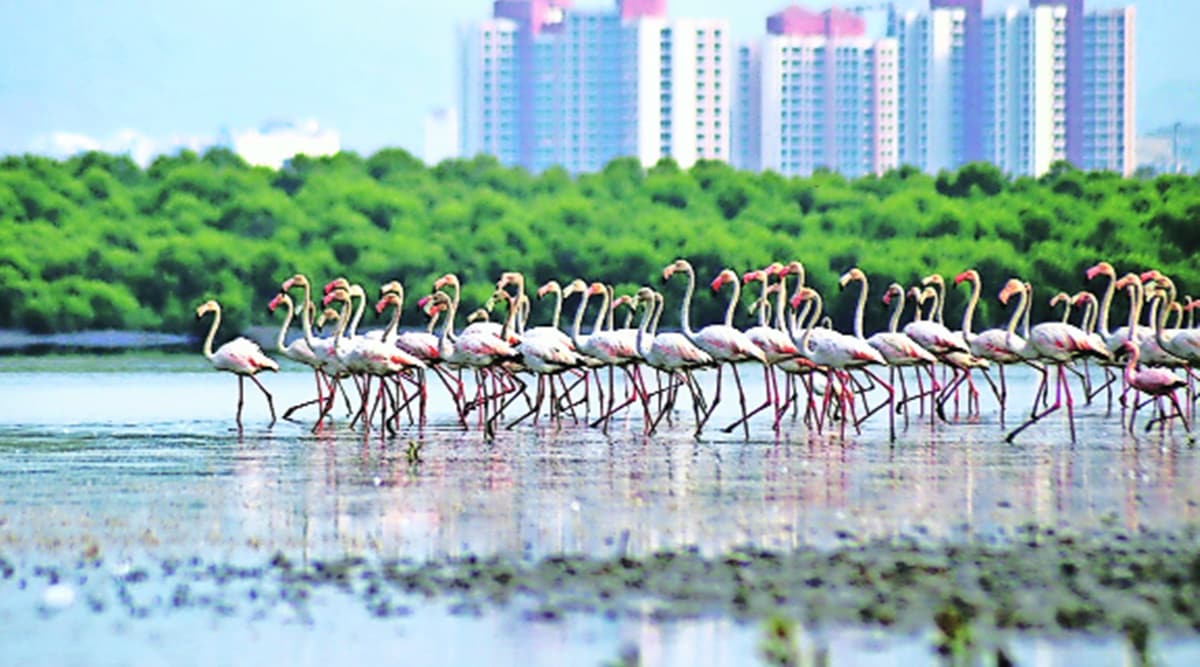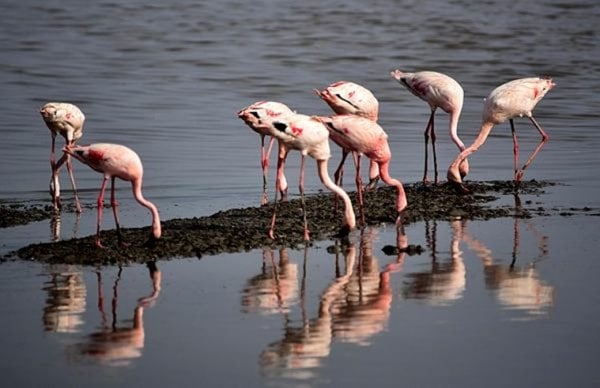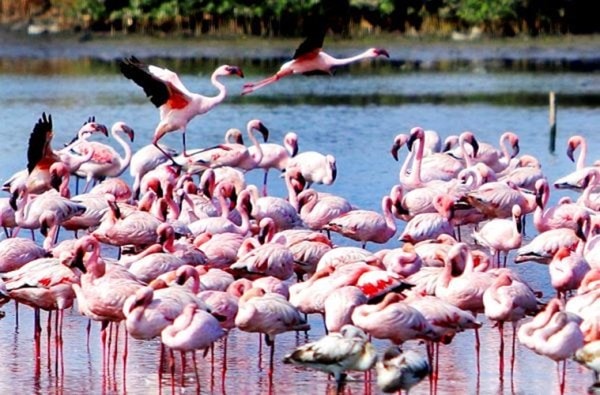 This is the highest since 2018, when BNHS annual flamingo monitoring exercise began. (Nandish Songire, Mangrove Foundation)
This is the highest since 2018, when BNHS annual flamingo monitoring exercise began. (Nandish Songire, Mangrove Foundation)THE Mumbai Metropolitan Region (MMR) has recorded the highest number of greater flamingos in 2021-22. This is the highest since 2018, when the Bombay Natural History Society (BNHS) annual flamingo monitoring exercise began.
Between December 2021 and March 2022, the Thane Creek Flamingo Sanctuary (TCFS) witnessed 54,000 greater flamingos. In pre-pandamic 2019, 25,000 greater flamingos were recorded at TCFS.
Rahul Khot, deputy director, BNHS, said, “The first time that a large number of greater flamingos was observed, around 8,000 of them in Sewai region, was in 1994 by a Mumbai Port Trust official. There has been no dedicated study since.”
 Flamingos seen during Flamingo festival at Sewri, Mumbai, April 22, 2022. (Express Archive)
Flamingos seen during Flamingo festival at Sewri, Mumbai, April 22, 2022. (Express Archive) Khot added that at present, he can’t pinpoint a reason behind the rise in the number, but some of the hypothesis are: Loss of their historic feeding grounds, increase in their population, or finding the Thane creek richer and resourceful. In Sewri and Nhava, 17,000 and 227 greater flamingos were recorded respectively. Juvenile (5%) and sub-adult (21%) numbers were lower than those of adults across the three regions.
This is a sharp increase, especially since the year before that (2020-21) when the greater flamingo abundance was the lowest (324-569) across all three regions and less than 2 per cent of the population recorded in the preceding two years.
Best of Express Premium
The population of the lesser flamingos has witnessed a marginal increase across all three locations – 65,000 at TCFS, 25,000 at Sewri, and 9000 at Nhava from December 2021 to March 2022.
“In the last couple of years, we observed a smaller number of greater flamingos. One of the reasons might be our inability to conduct surveys from March to May due to the pandemic restrictions. The highest number of flamingos is generally observed during these three months,” said Rahul Khot, deputy director, BNHS, adding that his team was currently investigating the reasons for this sharp increase.
‘
 A flock of Flamingos at the Thane Creek Flamingo Sanctuary, on April 30, 2022. (Express Archive)
A flock of Flamingos at the Thane Creek Flamingo Sanctuary, on April 30, 2022. (Express Archive)
Khot added, “Greater flamingos prefer freshwater and estuary environments, which Mumbai offers in plenty, thanks to its creeks and inland wetlands.”
Of the six species of flamingos in the world, two are found in India: the tallest of them, the greater flamingo (Phoenicopterus roseus) and the smallest one, the lesser flamingo (Phoeniconaias minor) between November and May. Greater flamingos have black-tipped light pinkish beaks, yellowish eyes, and pinkish-white body colour. They have a mixed feeding pattern and feed on insects, small fishes and algae. Their neck is a perfect S-shape while the lesser flamingos are more pink, with dark beaks and red eyes, and only feed on algae. Their neck is inverted (J shaped). The majority of flamingos that come to Mumbai are lesser flamingos.
Approximately 1,33,000 flamingos were observed this year (during April) across the TCFS, Sewri-Nhava and adjacent zones, said Khot. In comparison, 1,03,000 flamingos were spotted in 2020-21 (during February), 96,400 during 2019-20 (February), and 1,20,000 during 2018-19 (March).
Flamingos usually visit MMR wetlands from November to May mostly for feeding purposes from breeding sites in the Gujarat region as well as Iran. Migration from breeding grounds starts after the monsoon when water-filled regions start drying up. However, owing to the good availability of water over the past few years through winter, their arrivals have been delayed.
 Flamingos usually visit MMR wetlands from November to May mostly for feeding purposes from breeding sites in the Gujarat region as well as Iran. (Express Archive)
Flamingos usually visit MMR wetlands from November to May mostly for feeding purposes from breeding sites in the Gujarat region as well as Iran. (Express Archive) Since 2017, BNHS is conducting flamingo survey in the region as a part of a decadal survey project (up to 2027) – to map and count Mumbai’s migratory birds and to study the impact of the Mumbai Trans-Harbour Link on flamingos and other avifauna in the Thane Creek, Sewri, Nhava, and surrounding areas, as well as identify mitigation measures.
“In previous years, the TCFS reported over one lakh flamingos, including this exceptional record of the maximum number of greater flamingos this year. We intend to protect these migratory birds and their habitat for posterity. We had also proposed certification of TCFS for Ramsar Site (Wetlands of International Importance) and the same has been cleared by Chief Minister Uddhav Thackeray,” said Virendra Tiwari, Additional Principal Chief Conservator of Forests, Mangrove Cell.
- The Indian Express website has been rated GREEN for its credibility and trustworthiness by Newsguard, a global service that rates news sources for their journalistic standards.

